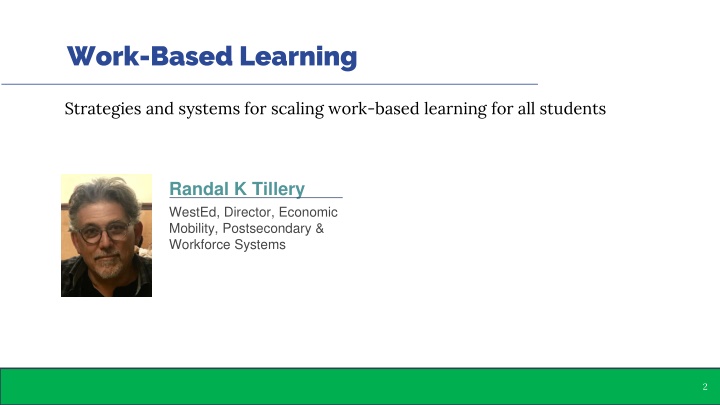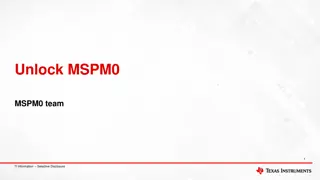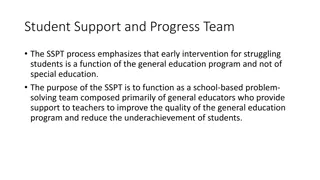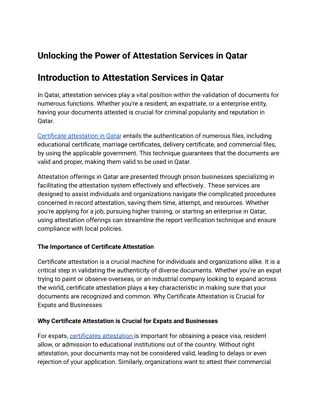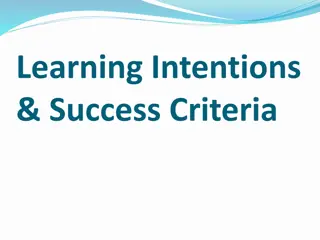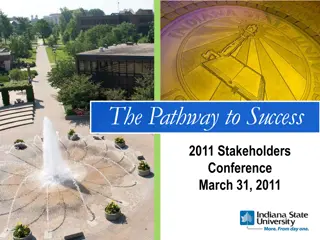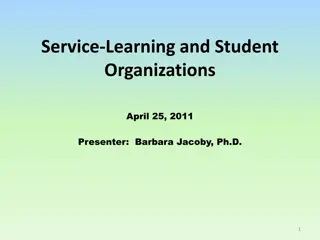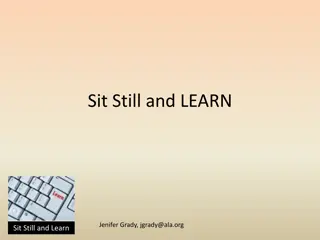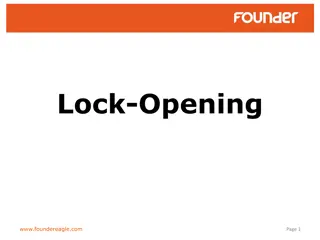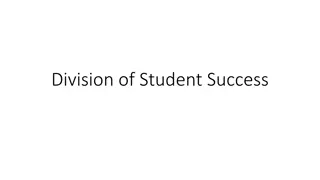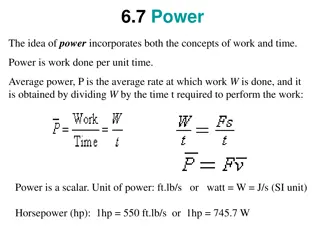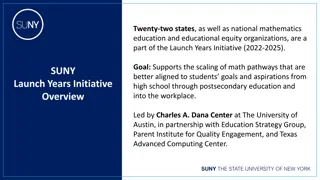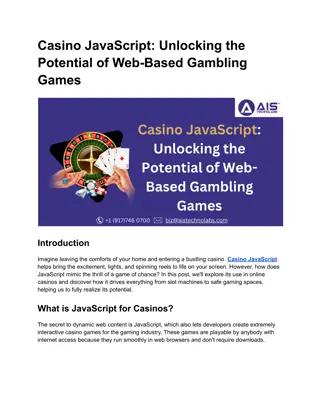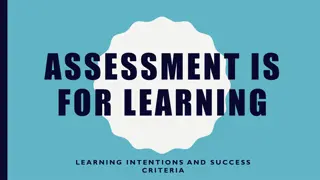Unlocking the Power of Work-Based Learning for Student Success
Explore the transformative impact of work-based learning (WBL) strategies and systems in scaling career readiness for all students. Gain insights on how institutions can strategically bridge the gap between education and the workforce, emphasizing WBL as a core feature. Discover the benefits of WBL in fostering student confidence, enhancing job market success, and boosting post-graduation earnings and job satisfaction. Engage in activities designed to prepare learners effectively for future careers and understand that WBL is a developmental experience, not merely a destination.
Download Presentation

Please find below an Image/Link to download the presentation.
The content on the website is provided AS IS for your information and personal use only. It may not be sold, licensed, or shared on other websites without obtaining consent from the author.If you encounter any issues during the download, it is possible that the publisher has removed the file from their server.
You are allowed to download the files provided on this website for personal or commercial use, subject to the condition that they are used lawfully. All files are the property of their respective owners.
The content on the website is provided AS IS for your information and personal use only. It may not be sold, licensed, or shared on other websites without obtaining consent from the author.
E N D
Presentation Transcript
Work-Based Learning Strategies and systems for scaling work-based learning for all students Randal K Tillery WestEd, Director, Economic Mobility, Postsecondary & Workforce Systems 2
WBL for All What Does it Mean Information Customers Institutions 2 1 3 We need to think strategically about the relationship between education and work Realize that education is a dual customer system serving learners and employers Systems, staffing, and partnerships that institutionalize WBL as a feature not an option
Activity: How are we preparing learners for careers? 1. Complete the three questions on the sheet in front of you where you are sitting 2. Find two other people who you do not work with and share your responses to the questions 3. Come back to together to share what you discussed
Why Work-Based Learning: Strada Center for Educational Insights: The Power of Work-Based Learning: WBL is linked to https://cci.stradaeducation.org/pv-release-march-16-2022/ Student Confidence they will be Successful in the Job Market Higher earnings after graduation Job Success and Job Satisfaction
WBL is not a Destination as Much as it is a Developmental Experience
WBL for All What Does it Mean Information Customers Institutions 2 1 3 We need to think strategically about the relationship between education and work Realize that education is a dual customer system serving learners and employers Systems, staffing, and partnerships that institutionalize WBL as a feature not an option
Play that Career! Let's Explore! What are the top 5 jobs for someone with a Bachelor's Degree in English? Call out your thoughts?
Exploration: Occupations by Bachelor s Degree https://bit.ly/3SFWg8C
Using occupational and skills Data 1. WBL is not only an occupational experience it can reinforce and inform skills in the curriculum. 2. Understanding the occupations that require certification, associates, and bachelor's degrees can inform WBL experiences for students at different places in their journey. 3. Occupational data and skills can help faculty understand what skills help their students most in achieving job success.
Questions? 1. How would you use this information to inform creating WBL Opportunities? 2. How could this information inform how you advise and bring students into your institution? 3. Are there implications for using this information in teaching and learning in the classroom?
WBL for All What Does it Mean Information Customers Institutions 2 1 3 We need to think strategically about the relationship between education and work Realize that education is a dual customer system serving learners and employers Systems, staffing, and partnerships that institutionalize WBL as a feature not an option
Dual Customer System Employers Learners Education
Concurrent Value Propositions Concurrent Value Propositions Employers Builds Value in the Training Pipeline Strengthens Investment in Future Talent Changes Misconceptions about Populations w Barriers Incentivizes Hiring from Trainees Learners/Jobseekers Understand Career Pathways/Opportunities Career & Workforce Readiness Reinforces Relevance of training curriculum Put Knowledge and Technical Skills into Practice Transition into Employment
Concurrent Value Propositions Concurrent Value Propositions Employers Builds Value in the Training Pipeline Strengthens Investment in Future Talent Changes Misconceptions about Populations w Barriers Incentivizes Hiring from Trainees Learners/Jobseekers Understand Career Pathways/Opportunities Career & Workforce Readiness Reinforces Relevance of training curriculum Put Knowledge and Technical Skills into Practice Transition into Employment
Building Strategic Industry Partnerships Internal Internal Leveraging existing employer advisory committees Leveraging Relationships from Cooperative Education Leveraging Resources from Career Center External External: : Employer Groups and Industry Associations Nonprofits and Community Organizations Workforce Boards and Economic Development Corporations Regional Sector Initiatives
Challenges Fragmentation (Pecked by Birds Problem) 1) K12, Colleges, Workforce Boards, & CBO s unique needs for industry engagement 2) Cluttered Business Landscape industry assoc. s, chambers, cities, EDCs Employer by Employer Relationships: Too much engagement between education and industry happens employer by employer or through individual program-based industry advisory committees. Limited Staffing: Maintaining successful partnerships takes time and staffing, but the level of staffing dedicated to creating and maintaining industry partnerships is light. Maintaining these partnerships, even with enthusiastic industry support, takes a lot of work. Leading with Hands Out: Educators tend to initiate conversations with Employers by asking for help and not how "We can help". Not enough focus is on issues or pain points faced by employers.
Model: Regional Sector or Industry Partnerships Model: Regional Sector or Industry Partnerships Agenda & priorities set by business leaders Industry champions who bring other employers to the table Addresses workforce & broader competitive needs of industry Supported by a broad-based team of public & community partners Over time, conversation shifts from pain points to actions & dialogue between education and industry * National Fund for Workforce Solutions: Characteristics of a High Performing Industry Partnership
Demand or Industry Driven Ideal State 1. Aligned to occupational and economic demand LMI/Economic Indicators 2. Based on specific needs for workers and skills identified and confirmed by local and regional employers 3. Employers are decision makers and leaders part of governance, co- designers of curriculum, pathway strategies, work-based learning, earn and learn strategies, and transition into employment 4. Opportunities for building connection between learners and employers through Work based learning and earn and learn strategies 5. Employers are champions that expand your industry networks and bring other businesses to the table
Emerging Model: Regional WBL Collaborative Emerging Model: Regional WBL Collaborative Intermediary system across institutions Sets uniform standards for WBL activities and definitions Centralized data platform for tracking employer and student data Central point of contact for employers Supported by industry champions Leverages regional business groups, workforce boards https://earnlearn.us/
Regional Collaborative: Pros and Cons 1. Time intensive to build: longest time is to build common definitions and understanding across systems 2. Requires trust building to agree to share employer relationships across systems and individual sites 3. Cuts through the siloing of employer engagement and WBL engagement and eliminates the pecked by birds problem 4. Creates a common platform for tracking learner and employer participation 5. Results in stronger levels of employer participation and employer support through investments to support the system
Huddle Questions? 1. Where would you go on your campus to learn about what employers work with your institution? 2. Does your institution centralize data about employers and measure how they participate? 3. Do you know how your institution matches students and employers as part of their educational experience?
WBL for All What Does it Mean Information Customers Institutions 2 1 3 We need to think strategically about the relationship between education and work Realize that education is a dual customer system serving learners and employers Systems, staffing, and partnerships that institutionalize WBL as a feature not an option
We have met the enemy and it is us Leadership Leadership WBL and Employer Partnerships must be an institutional priority Establish institutional and program level Outcomes Structural Structural: : Unify processes for employer engagement/reduce silos Dedicated staffing to support and maintain employer relationships Centralized marketing and data systems dedicated to this work Relationships Relationships: : Leverage capacity of workforce boards, industry associations, CBO s Cultivate industry champions to be the face of the work
Organizing Effectively Effective Planning: Bring faculty, staff, and leadership together Identify how it impacts curriculum and teaching across the institution: Can be a part of all courses in some form. Authentic and Engaging Experiences: Employers as co-creators of hands- on project-based experiences wherever possible Support for Employers: Who to call if there are challenges or questions Support Learner Growth: Connected to learner career plan and provide learner support and preparation Opportunities for Reflection and Feedback: Learners, Employers, & Educators Assess and Document the Experience
Rapid Design: Building your WBL Workplan At your seat, use the WBL workplan template to rapidly sketch out how you would take this on at your institution (5-10 mins) Quickly huddle with someone near you to discuss your plan and share ideas about challenges and opportunities We will come back for a rapid popcorn share out and our closing.
Closing with a Story: Warehouse Operations Logistics Training Program A 12-week intensive warehouse operations and logistics training program targeting formerly homeless and incarcerated adults includes three WBL activities: Distribution Center Tours: Participants visit multiple warehouse and distribution sites and meet CEO s and Managers 1. Warehouse Design Project: Employers provide feedback, assess, and grade group warehouse design projects 2. Mock Interviews: Employers participate in a mock interview process for participants to practice their interview skills 3. Over successive cohorts, employers begin calling in advance to volunteer for next cohort activities and to learn about when next cohorts are graduating so they can hire in advance
Thank You rtiller@wested.org 209 505 3965
